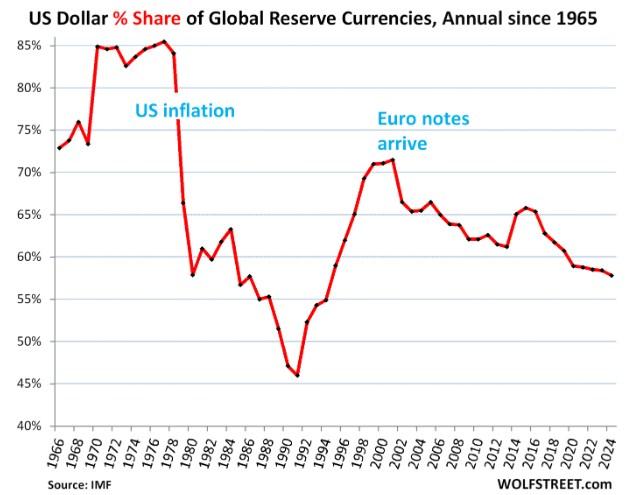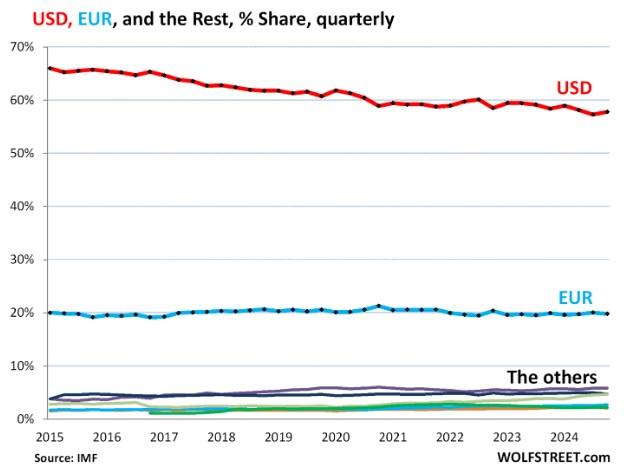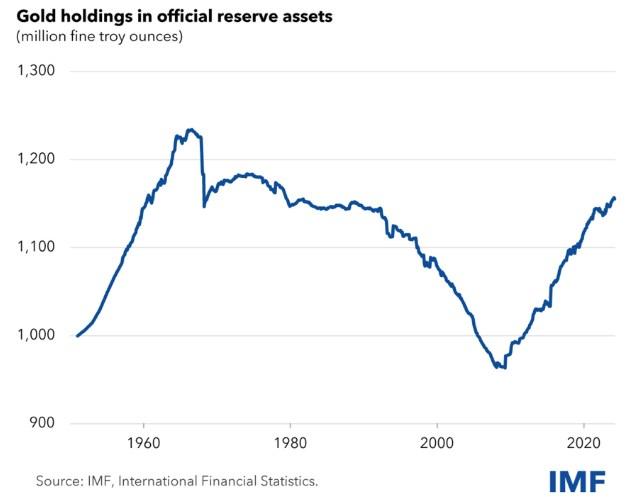The position of the US dollar as an important global reserve asset is steadily eroding
Wolf Richter, an analyst and publisher of Wolf Street, stated that gold and other reserve currencies (but not the euro or yuan) are steadily eroding the position of the US dollar as a significant global reserve asset.
Richter wrote in an article published on Monday: "The position of the US dollar as the world's major reserve currency helps the United States to fund its double deficits, making them possible: huge annual fiscal deficits and huge annual trade deficits. The position of the reserve currency comes from other central banks (not the Federal Reserve) buying trillions of dollars worth of assets, such as US treasury bond bonds, other government securities, corporate bonds, and even stocks. The position of the US dollar as the major reserve currency is crucial to the United States. As this dominance slowly declines, risks also slowly accumulate."
Richter cited the latest COFER data from the International Monetary Fund (IMF), which shows that the position of the US dollar as the world's top reserve currency will further decline in 2024.
He pointed out, "The total amount of US dollar denominated securities held by other central banks (excluding the Federal Reserve) decreased by $59 billion, from $6.69 trillion at the end of 2023 to $6.63 trillion at the end of 2024. At the end of 2024, the share of the US dollar in total foreign exchange reserves dropped to 57.8%, the lowest level since 1994, a decrease of 7.3% in 10 years, as central banks around the world have been diversifying their assets, denominated in currencies other than the US dollar, and buying gold
Figure 1: Share of the US dollar in global reserve currencies since 1965 (annual)
At the same time, the foreign exchange reserves of all currencies, including the US dollar, by central banks increased from $12.35 trillion in 2023 to $12.36 trillion in 2024.
He said: "The total amount does not include any central bank's assets denominated in local currency, such as US treasury bond bonds and mortgage-backed securities (MBS) held by the Federal Reserve, euro denominated bonds held by the European Central Bank, and yen denominated assets held by the Bank of Japan."
The share of the US dollar in foreign exchange reserves has not lost to the euro. Richter pointed out, "The euro has always been the world's second-largest reserve currency, with holdings of $2.27 trillion at the end of 2024. Over the years, its share has been around 20%, with a low of 19.1% in 2016 and a high of 21.3% in 2020. In the fourth quarter, the euro's share was 19.8%

Figure 2: Share of USD, EUR, and other currencies (quarterly)
Therefore, the reserve share of the US dollar has actually lost to other non euro currencies, including what the IMF calls "non-traditional reserve currencies". He said, "The colored cluster at the bottom of the chart represents the largest among other reserve currencies
According to IMF data, the top non-traditional reserve currencies are the Japanese yen (5.8%), British pound (4.7%), Canadian dollar (2.8%), Chinese yuan (2.2%), Australian dollar (2.1%), and Swiss franc (0.2%). All other currencies together account for 4.6% of global foreign exchange reserves.
Another major beneficiary of the decline in the status of the US dollar as a reserve currency is gold. After spending 40 years reducing their gold reserves, central banks around the world began to increase their gold reserves again about 20 years ago.
Richter pointed out, "Gold bars are not the 'foreign exchange reserve' assets of central banks in various countries, and therefore are not included in the above data. Gold is a 'reserve asset' that does not involve foreign exchange
He pointed out that the top four central banks in terms of gold reserves (8133 tons in the United States, 3352 tons in Germany, 2452 tons in Italy, and 2437 tons in France) have not changed their holdings for at least 20 years.
He added, "But there have been many changes behind the top four, especially Russia, which is now the fifth largest holder. Russia: 2333 tons, almost unchanged since the second quarter of 2022. But between 2005 and 2022, Russia, one of the world's largest gold producers, added nearly 2000 tons of gold
He pointed out that smaller holders such as Poland, India, Kyrgyzstan, and Uzbekistan increased their holdings of gold last year.
Richter wrote, "According to the IMF's updated 2024 data, central banks' gold holdings surged by approximately 200 million troy ounces (6221 tons) to 1.16 billion troy ounces in 2006

Figure 3: Gold holdings in official reserve assets (million troy ounces)
He said, "Calculated in US dollars and at today's prices, these gold holdings reach $3.65 trillion
Tips:This page came from Internet, which is not standing for FXCUE opinions of this website.
Statement:Contact us if the content violates the law or your rights
